Improving the Quality of Experience of Video Streaming Through a Buffer-Based Adaptive Bitrate Algorithm and Gated Recurrent Unit-Based Network Bandwidth Prediction
Abstract
1. Introduction
- We propose a GRU based network bandwidth prediction model.
- We select the rate of the next video chunk based on the predicted network bandwidth and buffer occupancy.
- We evaluate and compare the QoE of the proposed scheme. Our scheme outperforms BBA in QoE by approximately 11%.
2. Background
2.1. ABR Algorithm
2.2. BBA
3. Related Work
4. Methodology
4.1. Network Bandwidth-Learning Dataset
4.2. Network Bandwidth Prediction
4.3. Buffer-Based ABR Scheme
| Algorithm 1 Next video rate selection |
| Require: prev_rate: previous video rate Require: current_buffer: current buffer occupancy Require: bandwidth_prediction: predicted network bandwidth for next chunk Ensure: next_rate: next video chunk rate
|
5. Performance Evaluation
5.1. Performance Evaluation of the Network-Bandwidth Prediction Model
5.2. Performance Evaluation of the Buffer-Based ABR Technique Using Predicted Network Bandwidth Values
6. Conclusions
Author Contributions
Funding
Institutional Review Board Statement
Informed Consent Statement
Data Availability Statement
Conflicts of Interest
Abbreviations
| GRU | Gated Recurrent Unit |
| ABR | Adaptive Bitrate |
| RNN | Recurrent Neural Network |
| RTT | Round-Trip Time |
| RMSE | Root Mean Squared Error |
| MOS | Mean Opinion Score |
References
- Sandvine. Global Internet Phenomena Report. 2023. Available online: https://www.sandvine.com/hubfs/Sandvine_Redesign_2019/Downloads/2023/reports/Sandvine%20GIPR%202023.pdf (accessed on 26 August 2024).
- Wang, M.; Xu, C.; Jia, S.; Muntean, G.M. Video streaming distribution over mobile Internet: A survey. Front. Comput. Sci. 2018, 12, 1039–1059. [Google Scholar] [CrossRef]
- Bentaleb, A.; Taani, B.; Begen, A.C.; Timmerer, C.; Zimmermann, R. A survey on bitrate adaptation schemes for streaming media over HTTP. IEEE Commun. Surv. Tutorials 2018, 21, 562–585. [Google Scholar] [CrossRef]
- Huang, T.Y.; Johari, R.; McKeown, N.; Trunnell, M.; Watson, M. A buffer-based approach to rate adaptation: Evidence from a large video streaming service. In Proceedings of the 2014 ACM Conference on SIGCOMM, Chicago, IL, USA, 17–22 August 2014; pp. 187–198. [Google Scholar]
- Spiteri, K.; Urgaonkar, R.; Sitaraman, R.K. BOLA: Near-optimal bitrate adaptation for online videos. IEEE/ACM Trans. Netw. 2020, 28, 1698–1711. [Google Scholar] [CrossRef]
- Spiteri, K.; Sitaraman, R.; Sparacio, D. From theory to practice: Improving bitrate adaptation in the DASH reference player. ACM Trans. Multimed. Comput. Commun. Appl. (TOMM) 2019, 15, 1–29. [Google Scholar] [CrossRef]
- Jiang, J.; Sekar, V.; Zhang, H. Improving fairness, efficiency, and stability in http-based adaptive video streaming with festive. In Proceedings of the 8th International Conference on Emerging Networking Experiments and Technologies, Nice, France, 10–13 December 2012; pp. 97–108. [Google Scholar]
- Lekharu, A.; Moulii, K.; Sur, A.; Sarkar, A. Deep learning based prediction model for adaptive video streaming. In Proceedings of the 2020 International Conference on COMmunication Systems & NETworkS (COMSNETS), Bengaluru, India, 7–11 January 2020; IEEE: Piscataway, NJ, USA, 2020; pp. 152–159. [Google Scholar]
- Huang, T.; Zhang, R.X.; Yao, X.; Wu, C.; Sun, L. Being more effective and interpretable: Bridging the gap between heuristics and AI for ABR algorithms. In Proceedings of the ACM SIGCOMM 2019 Conference Posters and Demos, Beijing, China, 19–24 August 2019; pp. 12–14. [Google Scholar]
- Huang, T.; Zhou, C.; Zhang, R.X.; Wu, C.; Yao, X.; Sun, L. Stick: A harmonious fusion of buffer-based and learning-based approach for adaptive streaming. In Proceedings of the IEEE INFOCOM 2020-IEEE Conference on Computer Communications, Virtually, 6–9 July 2020; IEEE: Piscataway, NJ, USA, 2020; pp. 1967–1976. [Google Scholar]
- Souane, N.; Bourenane, M.; Douga, Y. Deep reinforcement learning-based approach for video streaming: Dynamic adaptive video streaming over HTTP. Appl. Sci. 2023, 13, 11697. [Google Scholar] [CrossRef]
- Naresh, M.; Gireesh, N.; Saxena, P.; Gupta, M. Sac-abr: Soft actor-critic based deep reinforcement learning for adaptive bitrate streaming. In Proceedings of the 2022 14th International Conference on COMmunication Systems & NETworkS (COMSNETS), Bengaluru, India, 4–8 January 2022; IEEE: Piscataway, NJ, USA, 2022; pp. 353–361. [Google Scholar]
- Naresh, M.; Saxena, P.; Gupta, M. Ppo-abr: Proximal policy optimization based deep reinforcement learning for adaptive bitrate streaming. In Proceedings of the 2023 International Wireless Communications and Mobile Computing (IWCMC), Marrakesh, Morocco, 19–23 June 2023; IEEE: Piscataway, NJ, USA, 2023; pp. 199–204. [Google Scholar]
- Ravindran, A.A. Internet-of-Things Edge Computing Systems for Streaming Video Analytics: Trails Behind and the Paths Ahead. IoT 2023, 4, 486–513. [Google Scholar] [CrossRef]
- Taleb, T.; Samdanis, K.; Mada, B.; Flinck, H.; Dutta, S.; Sabella, D. On multi-access edge computing: A survey of the emerging 5G network edge cloud architecture and orchestration. IEEE Commun. Surv. Tutorials 2017, 19, 1657–1681. [Google Scholar] [CrossRef]
- Kanai, K.; Imagane, K.; Katto, J. Overview of multimedia mobile edge computing. ITE Trans. Media Technol. Appl. 2018, 6, 46–52. [Google Scholar]
- Zhang, Q.; Sun, H.; Wu, X.; Zhong, H. Edge video analytics for public safety: A review. Proc. IEEE 2019, 107, 1675–1696. [Google Scholar] [CrossRef]
- Cho, K. Learning phrase representations using RNN encoder-decoder for statistical machine translation. arXiv 2014, arXiv:1406.1078. [Google Scholar]
- Chung, J. Empirical evaluation of gated recurrent neural networks on sequence modeling. arXiv 2014, arXiv:1412.3555. [Google Scholar]
- Dinaki, H.E.; Shirmohammadi, S.; Janulewicz, E.; Côté, D. Forecasting video QoE with deep learning from multivariate time-series. IEEE Open J. Signal Process. 2021, 2, 512–521. [Google Scholar] [CrossRef]
- Raman, A.; Turkkan, B.; Kosar, T. LL-GABR: Energy Efficient Live Video Streaming Using Reinforcement Learning. arXiv 2024, arXiv:2402.09392. [Google Scholar]
- Huu, T.V.; Huong, T.N.T.; Le, H.C. QoE Aware Video Streaming Scheme Utilizing GRU-based Bandwidth Prediction And Adaptive Bitrate Selection For Heterogeneous Mobile Networks. IEEE Access 2024, 12, 45785–45795. [Google Scholar] [CrossRef]
- ur Rahman, W.; Chung, K. Buffer-based adaptive bitrate algorithm for streaming over HTTP. KSII Trans. Internet Inf. Syst. (TIIS) 2015, 9, 4585–4603. [Google Scholar]
- Jiang, X.; Yu, F.R.; Song, T.; Leung, V.C. A survey on multi-access edge computing applied to video streaming: Some research issues and challenges. IEEE Commun. Surv. Tutorials 2021, 23, 871–903. [Google Scholar] [CrossRef]
- Bilal, K.; Erbad, A. Edge computing for interactive media and video streaming. In Proceedings of the 2017 Second International Conference on Fog and Mobile Edge Computing (FMEC), Valencia, Spain, 8–11 May 2017; IEEE: Piscataway, NJ, USA, 2017; pp. 68–73. [Google Scholar]
- Yang, S.R.; Tseng, Y.J.; Huang, C.C.; Lin, W.C. Multi-access edge computing enhanced video streaming: Proof-of-concept implementation and prediction/QoE models. IEEE Trans. Veh. Technol. 2018, 68, 1888–1902. [Google Scholar] [CrossRef]
- LTE Dataset. 2023. Available online: https://www.kaggle.com/datasets/aeryss/lte-dataset (accessed on 26 August 2024).
- Raca, D.; Quinlan, J.J.; Zahran, A.H.; Sreenan, C.J. Beyond throughput: A 4G LTE dataset with channel and context metrics. In Proceedings of the 9th ACM Multimedia Systems Conference, Amsterdam, The Netherlands, 12–15 June 2018; pp. 460–465. [Google Scholar]
- Rotman, M.; Wolf, L. Shuffling recurrent neural networks. In Proceedings of the AAAI Conference on Artificial Intelligence, Virtually, 2–9 February 2021; Volume 35, pp. 9428–9435. [Google Scholar]
- Lee, M.C. Research on the feasibility of applying GRU and attention mechanism combined with technical indicators in stock trading strategies. Appl. Sci. 2022, 12, 1007. [Google Scholar] [CrossRef]
- Paszke, A.; Gross, S.; Chintala, S.; Chanan, G.; Yang, E.; DeVito, Z.; Lin, Z.; Desmaison, A.; Antiga, L.; Lerer, A. Automatic Differentiation in Pytorch. 2017. Available online: https://openreview.net/forum?id=BJJsrmfCZ (accessed on 26 August 2024).
- Streijl, R.C.; Winkler, S.; Hands, D.S. Mean opinion score (MOS) revisited: Methods and applications, limitations and alternatives. Multimed. Syst. 2016, 22, 213–227. [Google Scholar] [CrossRef]
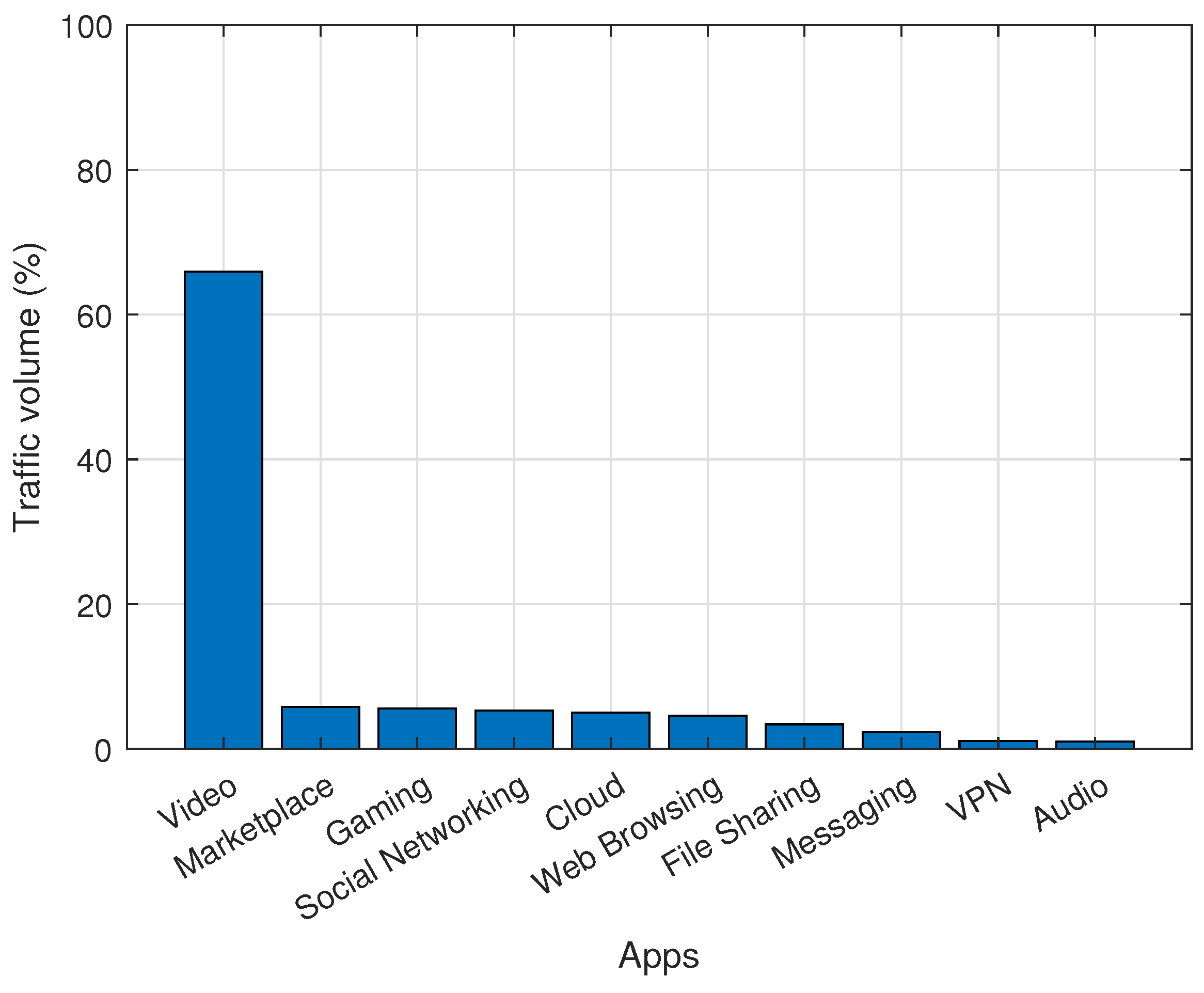
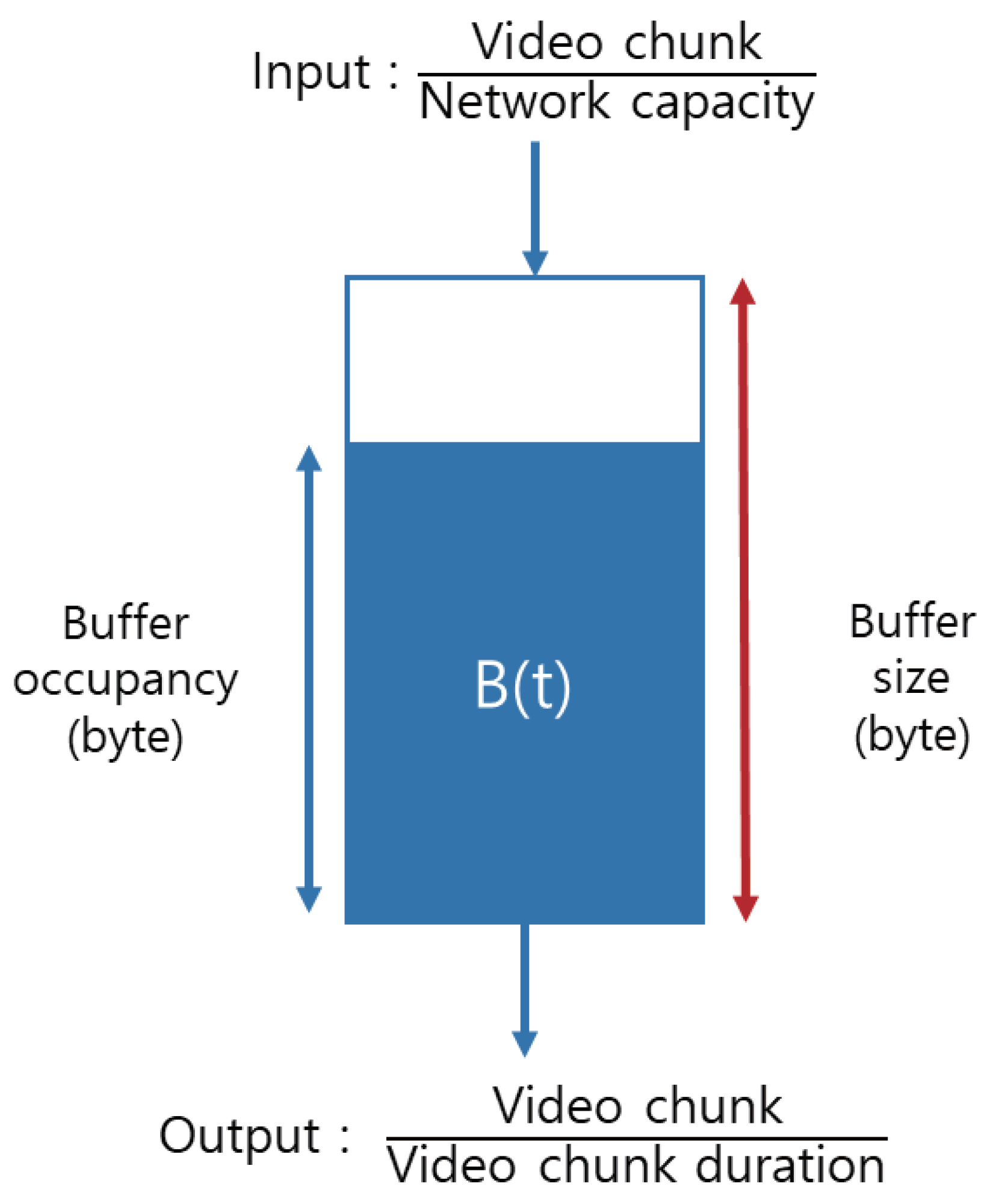
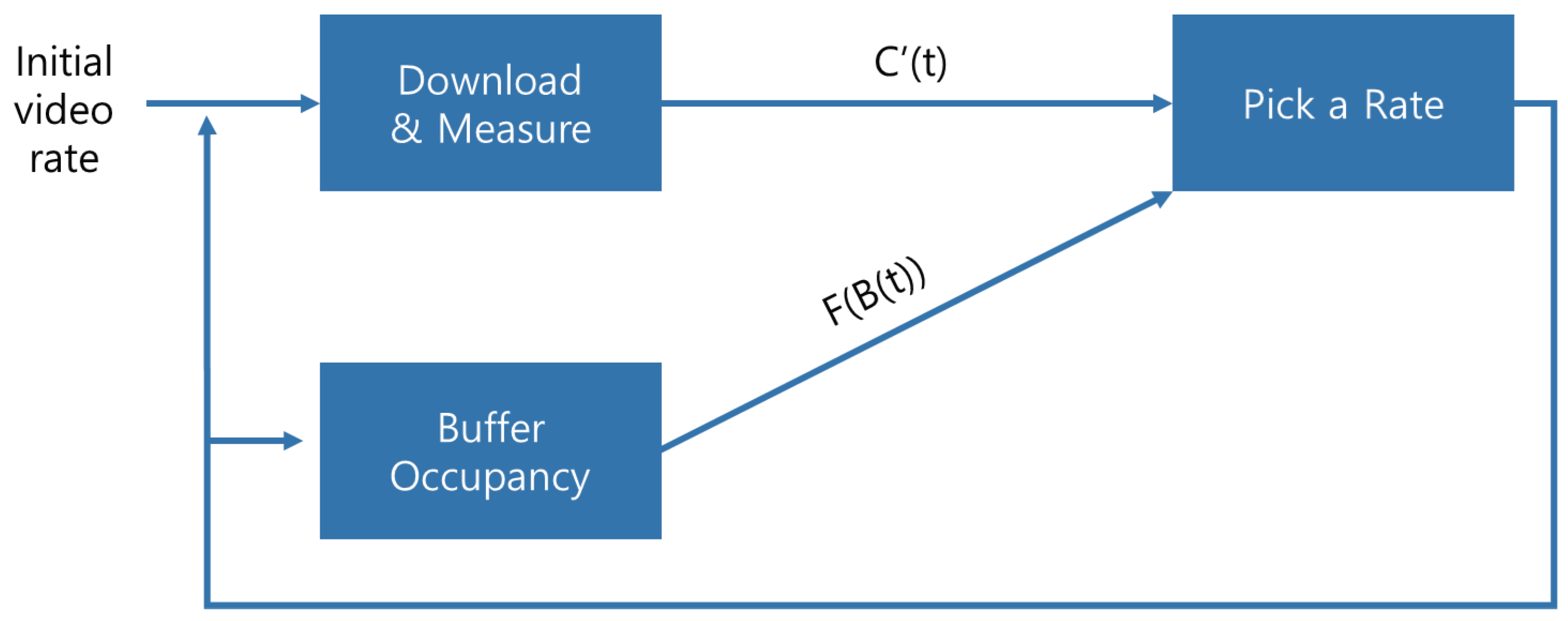

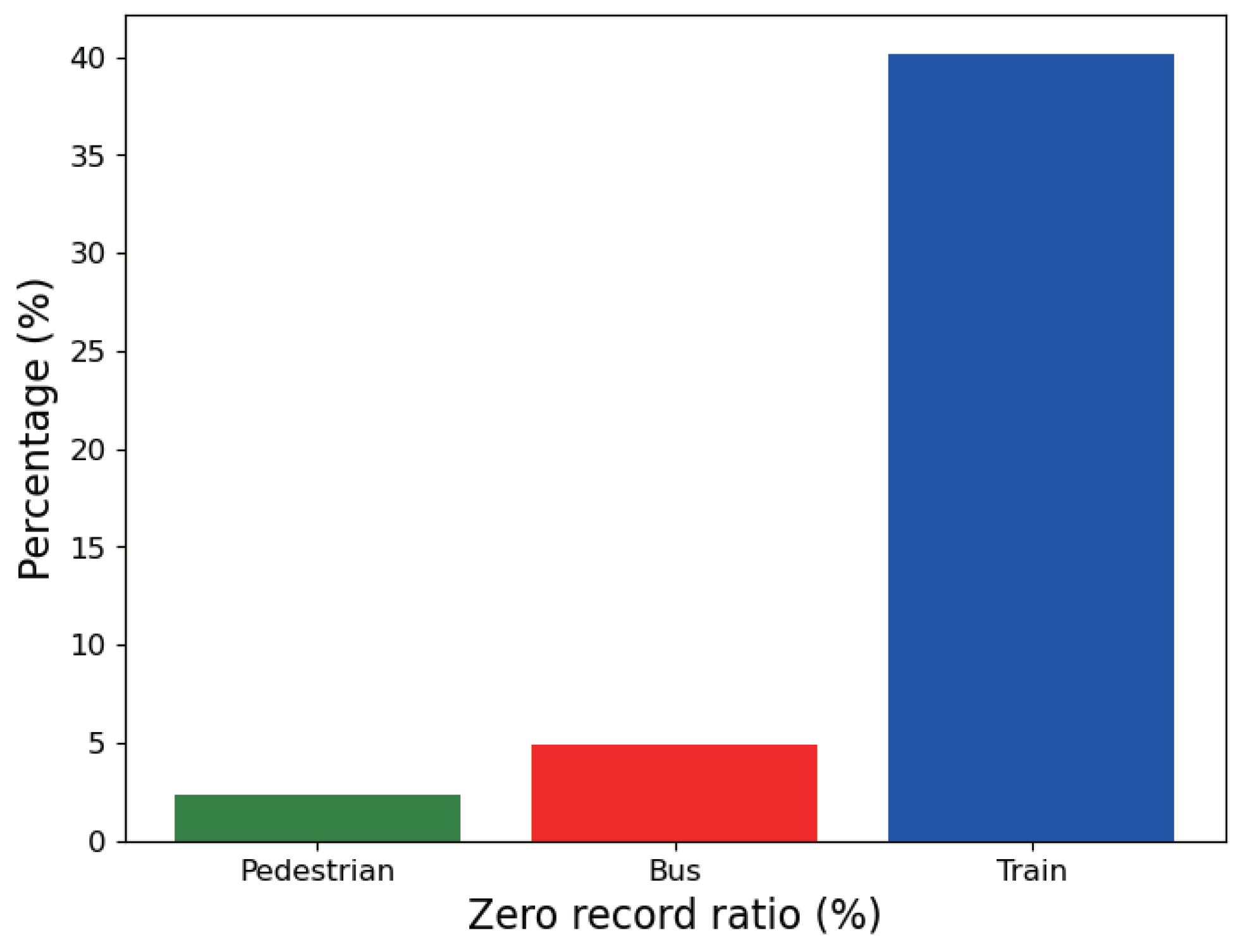
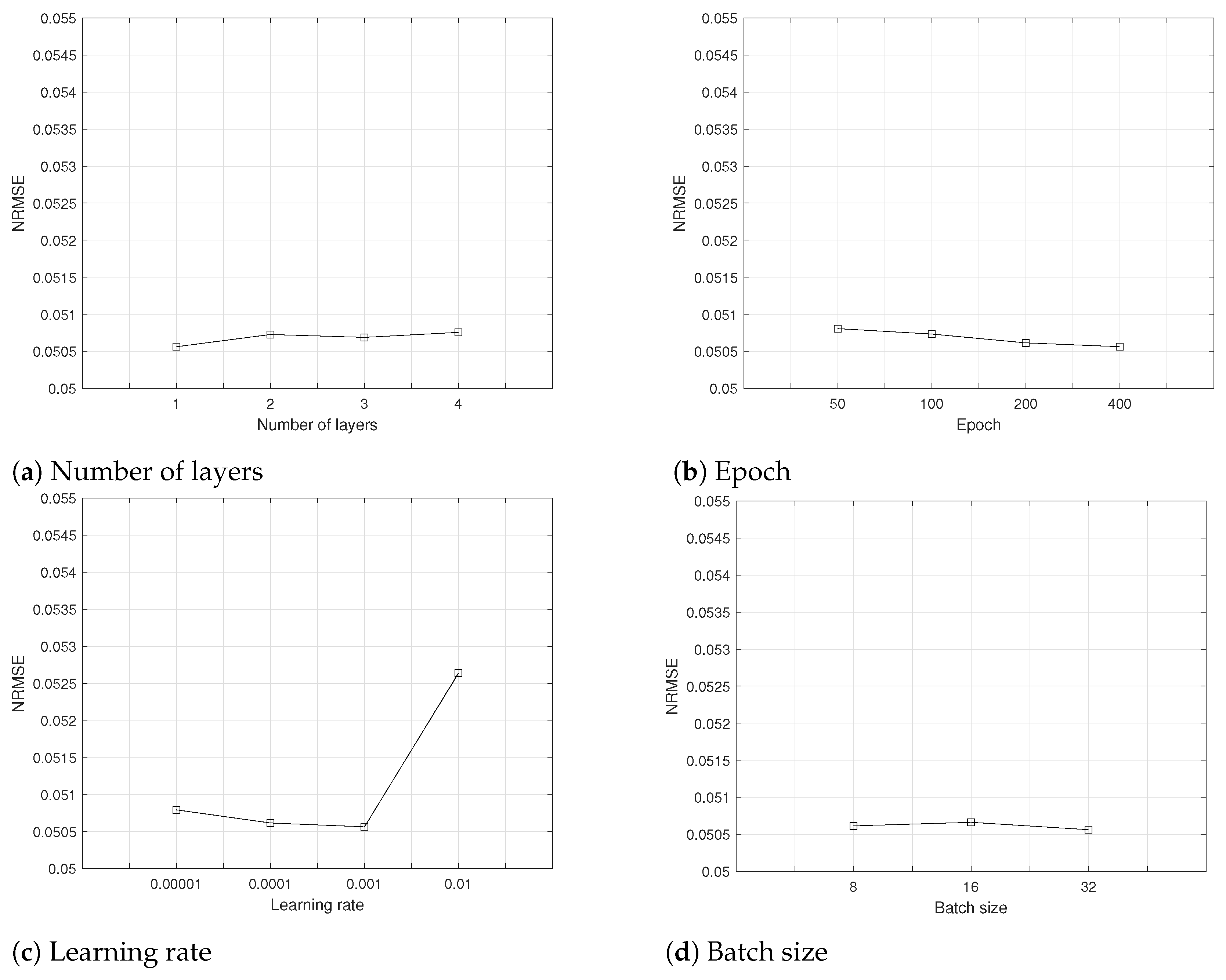

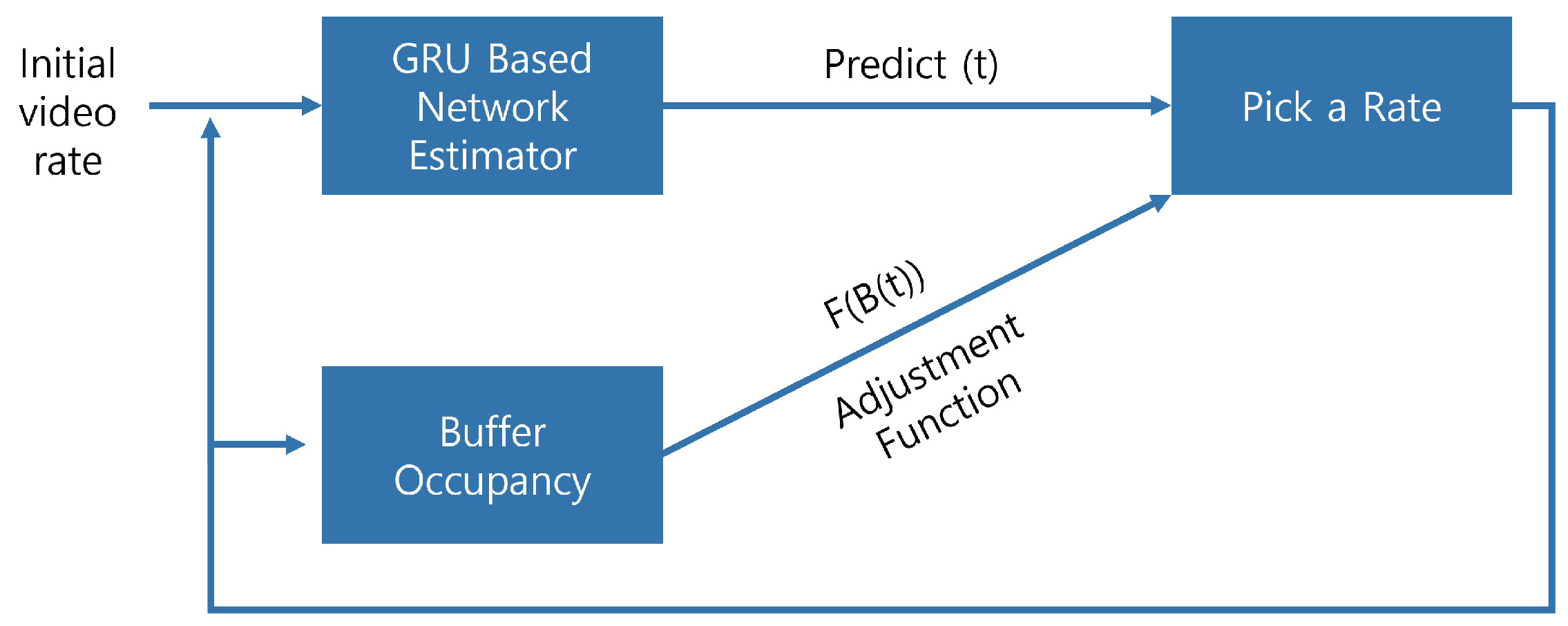
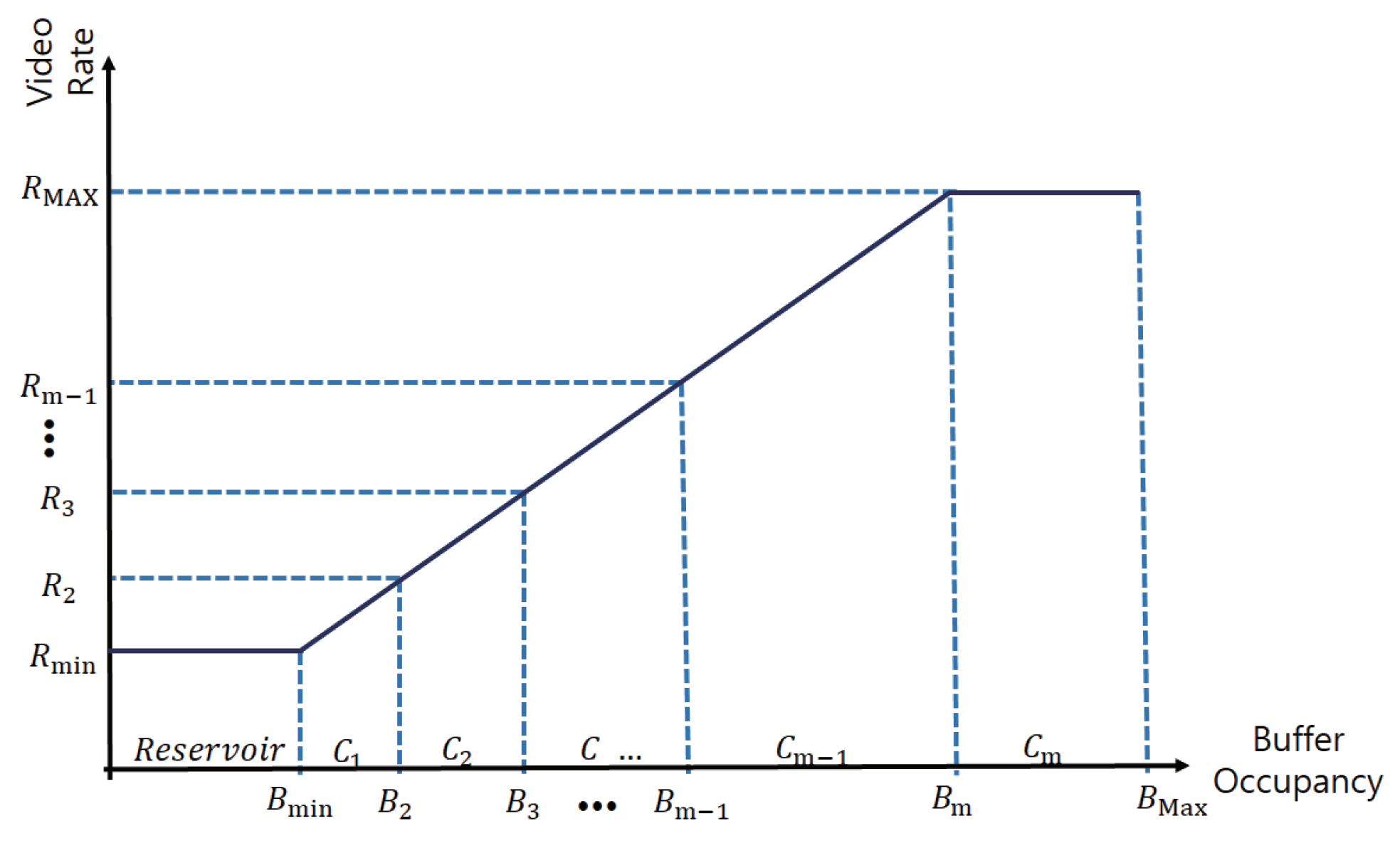





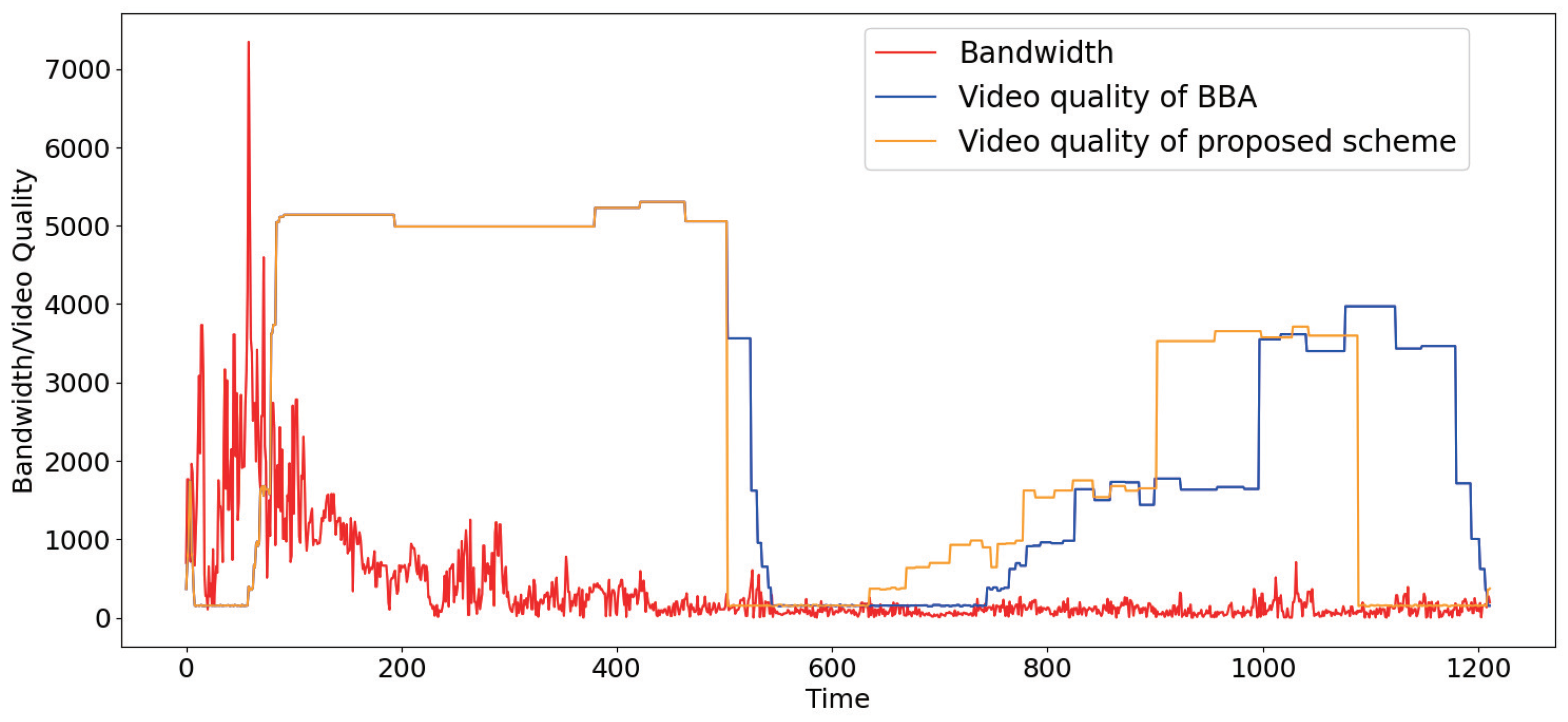
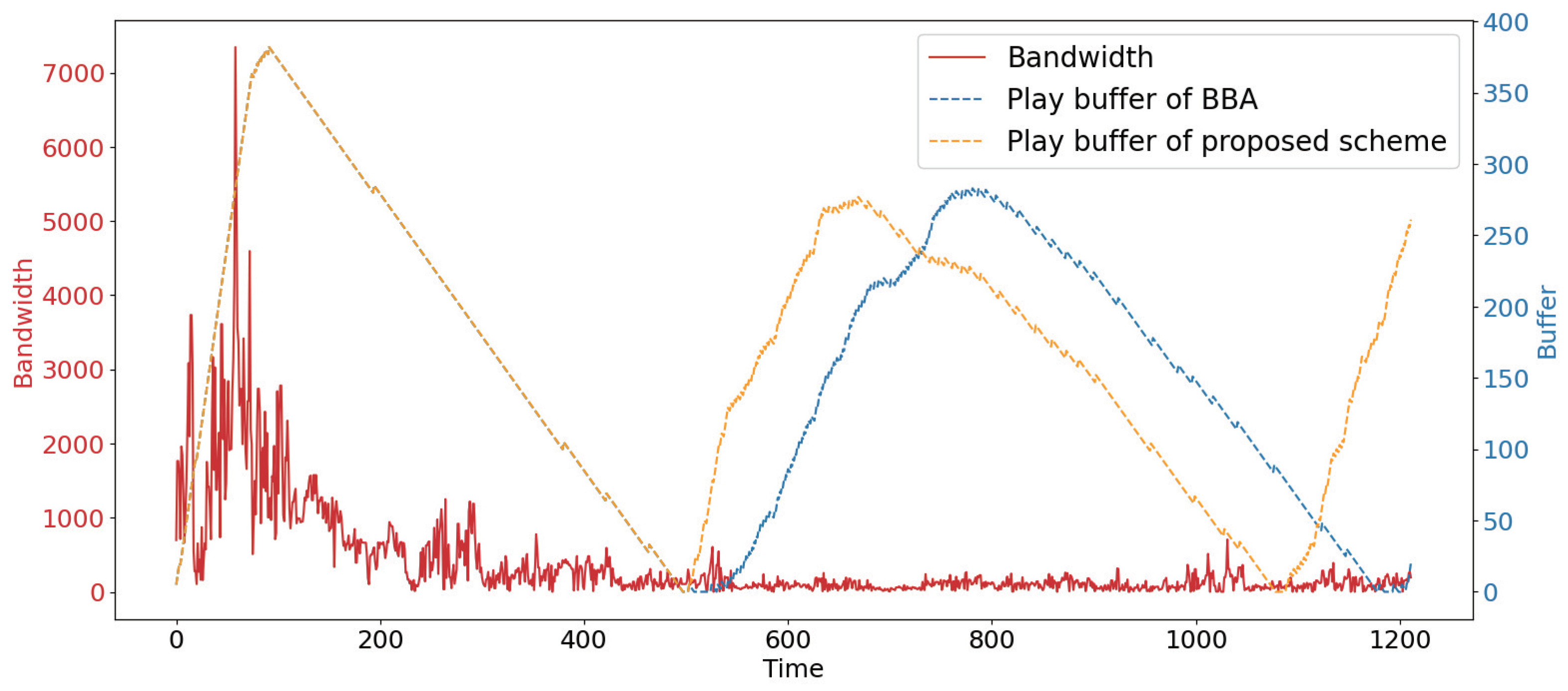
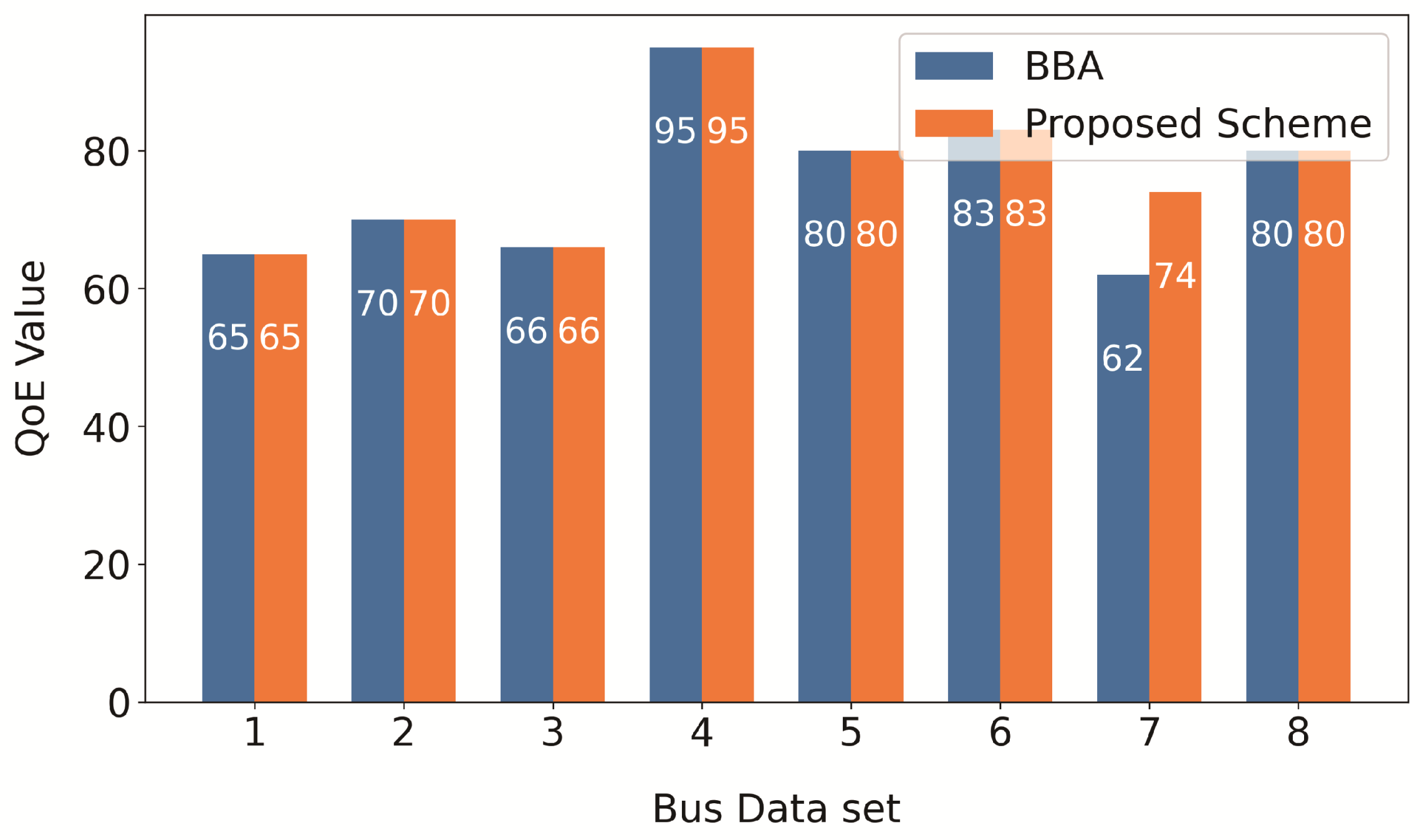
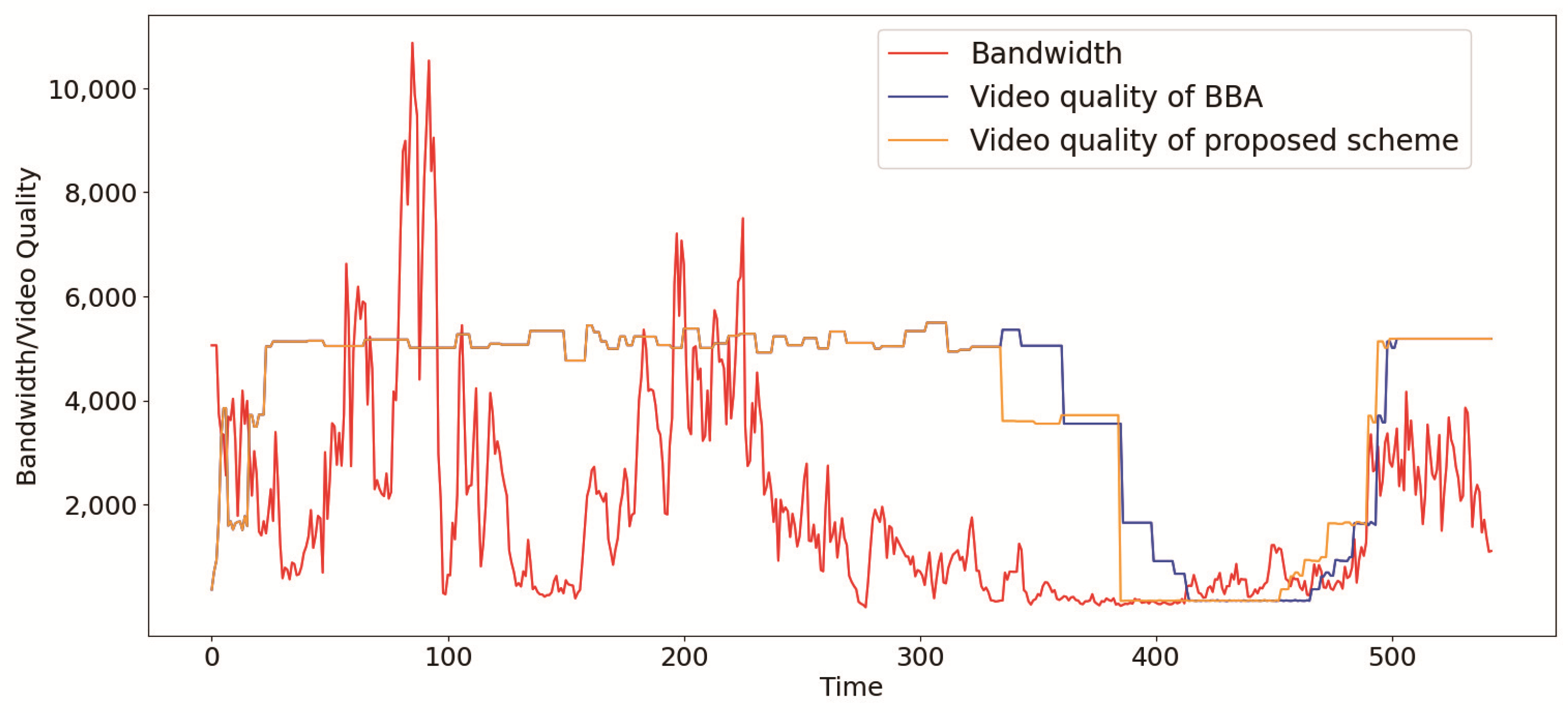
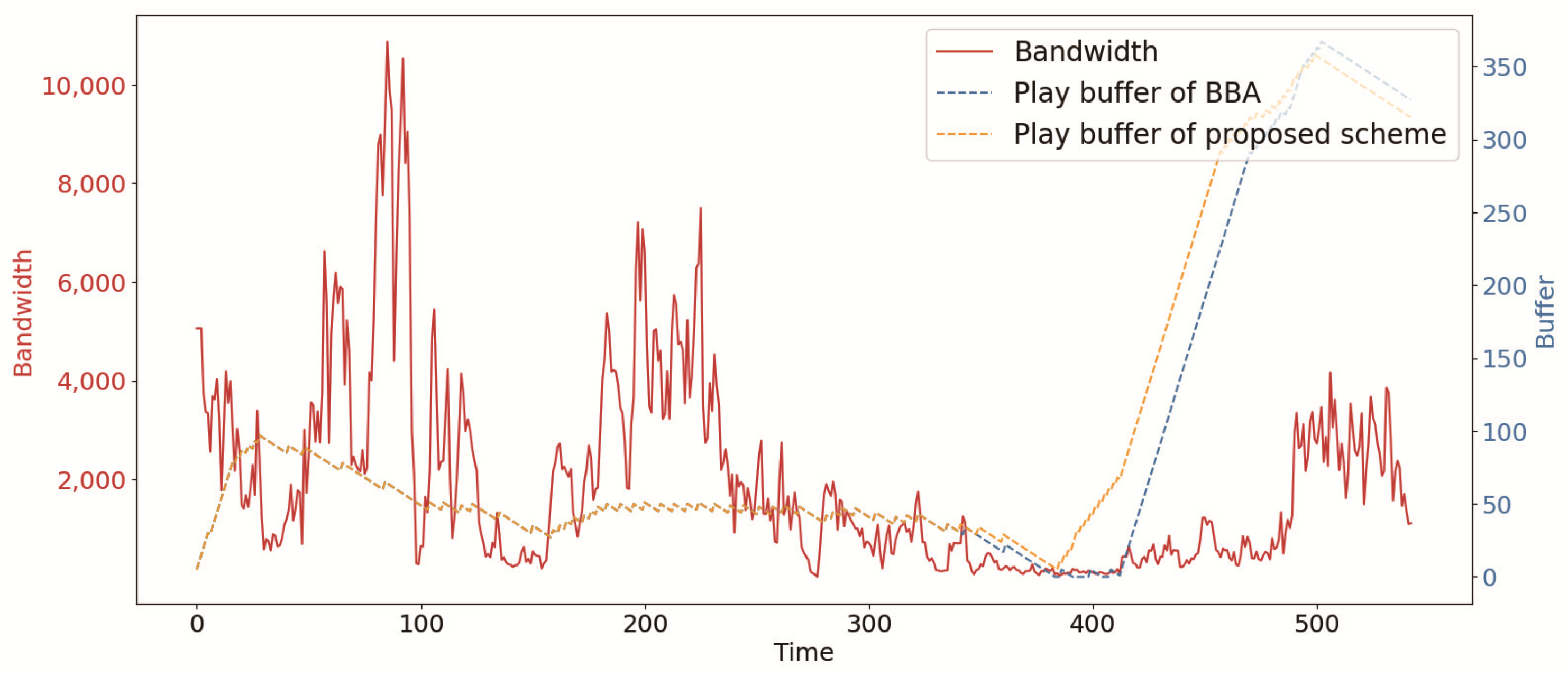
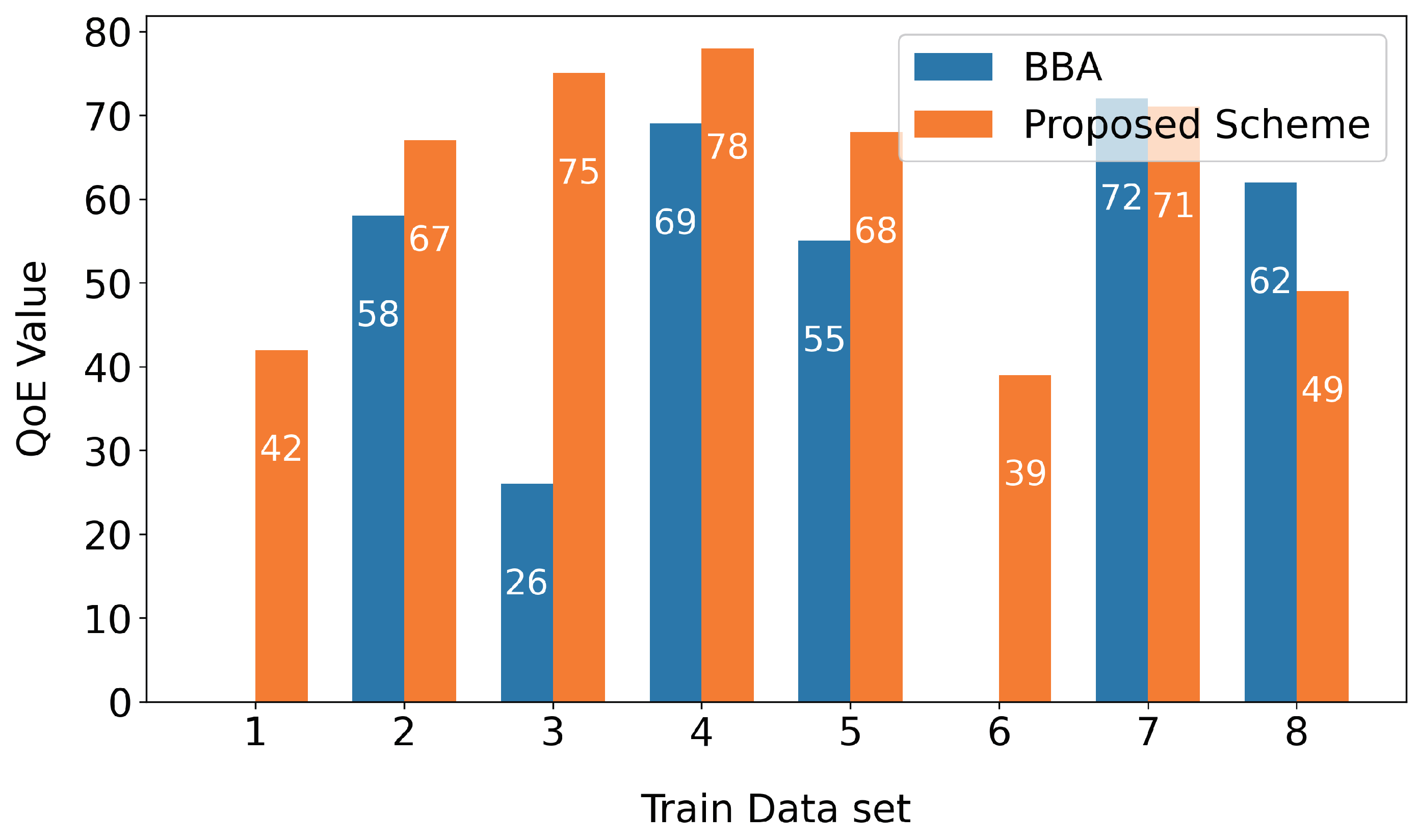
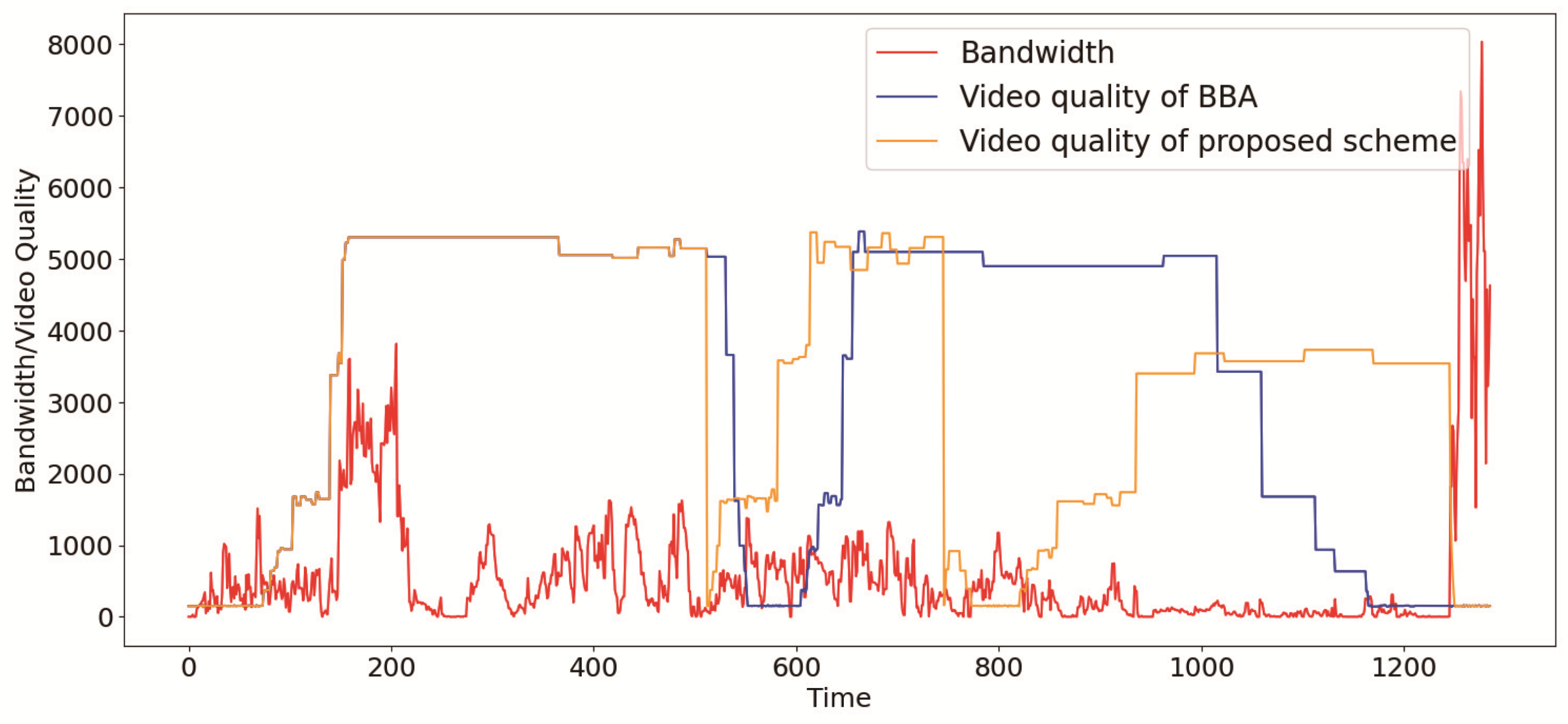

| Input size | 1 |
| Hidden state | 2 |
| Number of layers | 1 |
| Epochs | 400 |
| Learning rate | 0.001 |
| Sequence length | 20 |
| Batch size | 32 |
| Output size | 1 |
| Proposed Technique | BBA | |
|---|---|---|
| Average video quality | 2642 KB | 2615 KB |
| Number of video quality changes | 22 | 30 |
| Number of rebufferings | 15 | 32 |
| Proposed Technique | BBA | |
|---|---|---|
| Average video quality | 4060 KB | 4066 KB |
| Number of video quality changes | 16 | 20 |
| Number of rebufferings | 2 | 12 |
| Proposed Technique | BBA | |
|---|---|---|
| Average video quality | 3762 KB | 3668 KB |
| Number of video quality changes | 25 | 25 |
| Number of rebufferings | 28 | 119 |
Disclaimer/Publisher’s Note: The statements, opinions and data contained in all publications are solely those of the individual author(s) and contributor(s) and not of MDPI and/or the editor(s). MDPI and/or the editor(s) disclaim responsibility for any injury to people or property resulting from any ideas, methods, instructions or products referred to in the content. |
© 2024 by the authors. Licensee MDPI, Basel, Switzerland. This article is an open access article distributed under the terms and conditions of the Creative Commons Attribution (CC BY) license (https://creativecommons.org/licenses/by/4.0/).
Share and Cite
Woo, J.; Hong, S.; Kang, D.; An, D. Improving the Quality of Experience of Video Streaming Through a Buffer-Based Adaptive Bitrate Algorithm and Gated Recurrent Unit-Based Network Bandwidth Prediction. Appl. Sci. 2024, 14, 10490. https://doi.org/10.3390/app142210490
Woo J, Hong S, Kang D, An D. Improving the Quality of Experience of Video Streaming Through a Buffer-Based Adaptive Bitrate Algorithm and Gated Recurrent Unit-Based Network Bandwidth Prediction. Applied Sciences. 2024; 14(22):10490. https://doi.org/10.3390/app142210490
Chicago/Turabian StyleWoo, Jeonghun, Seungwoo Hong, Donghyun Kang, and Donghyeok An. 2024. "Improving the Quality of Experience of Video Streaming Through a Buffer-Based Adaptive Bitrate Algorithm and Gated Recurrent Unit-Based Network Bandwidth Prediction" Applied Sciences 14, no. 22: 10490. https://doi.org/10.3390/app142210490
APA StyleWoo, J., Hong, S., Kang, D., & An, D. (2024). Improving the Quality of Experience of Video Streaming Through a Buffer-Based Adaptive Bitrate Algorithm and Gated Recurrent Unit-Based Network Bandwidth Prediction. Applied Sciences, 14(22), 10490. https://doi.org/10.3390/app142210490







